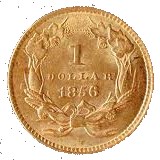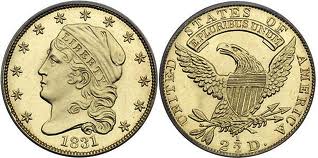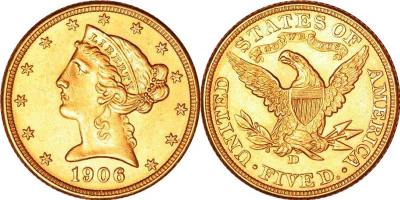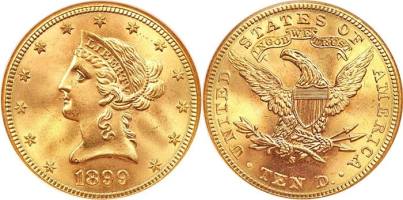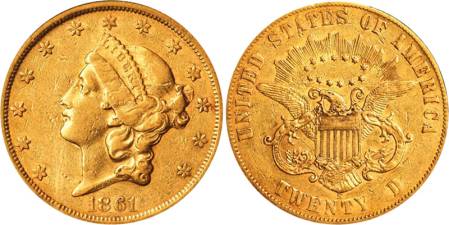What Are The Most Collectible US Mint Gold Coins
The United States Mint first started producing gold coins in 1795 for use as legal-tender pieces. Formerly circulated US gold coins that were manufactured from 1795 to 1933 are now considered rare US Mint gold coins.
The reason pre 1933 gold coins are considered rare is that in 1933 President Roosevelt enacted the gold confiscation act which forbid any citizen from owning gold, all the gold coins that were confiscated were then made into gold bars. It is said that millions of gold coins were confiscated and melted. As a result of the confiscation these coins became quite rare and collectible, let’s have a look at the different types.
There are are six types of pre 1933 general-circulation old US Mint gold coins that had been produced during this period, which include (in order of increasing face value):
US One Dollar Gold Coin:
Created by James Barton Longacre and has a face value of $1. It was first minted in the year 1849 and was last minted in 1889. There are three major design variations or “types” of Gold Dollars, the Liberty Head Gold Dollar (Type 1) which was issued by the US Mint from 1849 to 1854, the Indian Princess (small head) Gold Dollar (Type 2), which was issued from 1854 to 1855, and the Indian Princess (large head) Gold Dollar (Type 3), which was issued from 1856 to 1889.
The Type 1 Gold Dollar has a diameter of 12.7 millimeters and a weight of 1.7 grams. About 90.0% of its total mass is pure gold and the rest is copper (equivalent to .900 fine or 21.6 karats). The Type 1 Gold Dollar is the smallest coin in US history. The Type 2 Gold Dollar also weighs 1.7 grams as the Type 1, but is slightly larger, having a diameter of 14.3 millimeters. The Type 2 has a composition of 90.0% gold (and 10% silver and copper).
Types 2 and 3 are almost identical except for size and design changes mainly on the “Indian” princess’ head on the obverse side. The production of the Gold Dollar was authorized by the Coinage Act of March 3, 1849, which also included the authorization for the production of the Double Eagle.
US Quarter Eagle Gold Coin
Initially designed by Robert Scot and has a face value of $2.50. This gold coin was first minted in 1796 and was last minted in 1929. There are six types of Quarter Eagles. The Type 1 Quarter Eagle is otherwise known as the ‘Capped Bust Right Quarter Eagle’ or the ‘Turban Head Quarter Eagle’, which was issued from 1796 to 1807. The Type 2 was the Capped Bust (Head Left) Quarter Eagle or the Draped Bust Quarter Eagle, which was minted only in 1808.
Type 3 is also called the Capped Head Left Quarter Eagle or simply Capped Head Quarter Eagle, which was issued from 1821 to 1834. Type 4 is called the Classic Head Quarter Eagle, which was minted from 1834 until 1839. Type 5 is the Liberty Head Quarter Eagle or the Coronet Quarter Eagle, which was issued from 1840 to 1907. The final Type 6 is called the Indian Head Quarter Eagle, which was issued in 1908 until 1915, and then re-issued from 1925 to 1929.
Types 1, 2, and 3 have a diameter of 20 millimeters, a weight of 4.37 grams, and a gold content of 91.7%. The Type 4 Quarter Eagle was designed by William Kneass and has a diameter of 17.5 millimeters, a weight of 4.18 grams, and a gold content of 89.9%. The Type 5 was designed by Christian Gobrecht and has a diameter of 18 millimeters, a weight of 4.18 grams, and a gold content of 90.0%.
The Type 6 was created by Bela Lyon Pratt and has a diameter of 18 millimeters, a weight of 4.18 grams, and a gold content of 90.0%. The Indian Head Quarter Eagle is one of only two US Mint coins that has an incused relief (the other is the Type 6 Half Eagle). The Coinage Act of 1792 was responsible for establishing the United States Mint as well as authorizing the production of Dollars, Eagles, Dimes, Cents, and Milles coins.
US Three Dollar Gold Coin
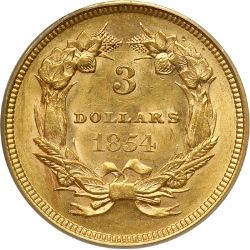 The Three Dollar Gold Coin also referred to as the Three Dollar Piece was designed by James B. Longacre and was released from 1854 to 1889. A diameter of 20.5 millimeters, a weight of 5.02 grams, and a gold content of 90.0%. This piece was intended to facilitate the sale of 3-dollar postage-stamp sheets that contained 100 individual pieces of 3-cent, first-class postage stamps. The production of the Three Dollar Gold Coin was initiated after the passing of the Mint Act of February 21, 1853. The Three Dollar gold piece series comprises the lowest total number of coins that were ever circulated in the country, only about half a million pieces from 1854 to 1889.
The Three Dollar Gold Coin also referred to as the Three Dollar Piece was designed by James B. Longacre and was released from 1854 to 1889. A diameter of 20.5 millimeters, a weight of 5.02 grams, and a gold content of 90.0%. This piece was intended to facilitate the sale of 3-dollar postage-stamp sheets that contained 100 individual pieces of 3-cent, first-class postage stamps. The production of the Three Dollar Gold Coin was initiated after the passing of the Mint Act of February 21, 1853. The Three Dollar gold piece series comprises the lowest total number of coins that were ever circulated in the country, only about half a million pieces from 1854 to 1889.
Half Eagle Gold Coin
The Us Half Eagle gold coin is a five-dollar coin that was manufactured and circulated from 1795 to 1929. There are six major types and two sub-types (or varieties) each for Types 1 and 5. Type 1 is called the Capped Bust (Turban Head) Half Eagle, which was issued from 1795 to 1807. Robert Scot designed both varieties of this type.
The Type 1 Half Eagles have a diameter of 25 millimeters, a weight of 8.75 grams, and gold content of 91.7%. The first variety (or sub-type) is the Draped Bust (Turban Head) Right (small eagle) type, which was struck from 1795 to 1798. The reverse of this coin features a spread-winged eagle clutching a leafy branch in its talons and clasping a wreath in its beak.
The second variety, the Draped Bust (Turban Head) Right (large eagle) type features a reverse face with a “heraldic” or coat-of-arms-type eagle clutching a bunch of arrows in its right foot and a branch on the left, with the Great Seal of the United States covering its chest. This second version of the Type 1 Half Eagle was minted from 1798 to 1807 (but some rare pieces had obverses with inscribed dates ranging from 1795 to 1797). The Type 2 Capped Bust Half Eagle that first appeared in 1807 and was last minted in 1812 was designed by John Reich, who was an engraver originally from Germany. This Type 2 Half Eagle has the same diameter, weight, and gold content as the Type 1.
Type 3 Half Eagle is the Capped Head Half Eagle, which was also designed by John Reich. This type was minted from 1813 to 1834. Its dimensions, weight, and gold content is the same as those of the earlier two types. In 1834, William Kneass designed the Classic Head Half Eagle (Type 4), which has a diameter of 23.8 millimeters, a weight of 8.24 g, and a gold content of 89.9% (90.0% starting in 1837). This type was last minted in 1838.
In 1839, the Type 5 Half Eagle was called the Liberty Head (or Coronet). This type has two varieties: the first one has no motto and was minted from 1839 to 1866, and the second variety (with motto) was minted from 1866 to 1908. The Liberty Head/Coronet without motto design was developed by Christian Gobrecht from the previous type’s design. This coin has a diameter of 22.5 millimeters (from 1839 to 1840) and a diameter of 21.65 millimeters (from late 1840 to 1866), a weight of 8.24 g, and a gold content of 90.0%. The Liberty Head/Coronet with the “IN GOD WE TRUST” motto above the eagle figure has a diameter of 21.65 millimeters, a weight of 8.24 g, and a gold content of 90.0%. It ran from 1866 to 1908. The Indian Head Half Eagle is the sixth and last type for the Half Eagle series. It was created by Bela Lyon Pratt to have a sunken or incused relief. Its diameter is 21.6 mls, weight is 8.24 g, and gold content is 90.0%. It was minted from 1908 through 1916, and then, for the last time, in 1929.
10 Dollar Gold Eagle
The Gold Eagle was the then largest base-unit of denomination for US coins. It’s face value of $10. The earliest Eagle (Type 1) was the Capped Bust (Turban Head) Eagle, which was designed by Robert Scot. This type has a diameter of 33 millimeters, a weight of 17.5 grams, and a gold content of 91.7%. This type has two versions, the first version’s reverse face features a small eagles that has a wreath in its beak and a branch in its feet. This version was stamped from 1795 to 1797.
The second version has a heraldic eagle on the reverse and the motto “E PLURIBUS UNUM.” This version was minted yearly starting in 1797 and ending in 1804. The second type (Liberty Head Eagle/Coronet) was designed by Christian Gobrecht and has a diameter of 26.8 millimeters, a weight of 16.7 grams, and a gold content of 90.0%. The first version of this Type 2 Eagle does not have the motto “IN GOD WE TRUST”, while the second version includes the motto on an unfurled scroll above the eagle’s head and wings.
The first version of the Type 2 was manufactured yearly from 1838 until 1866. In 1834, the gold content was reduced to 89.9% (21.58 karats), and then was returned again to 90.0% in 1837 (with silver totally excluded). The second version was stamped from 1866 to 1907. The third type of Eagle is the Indian Head Eagle which was designed by Augustus Saint-Gaudens. This Eagle has a diameter of 26.8 millimeters, a weight of 16.7 grams, and a gold content of 90.0%.
The first version and the second version are practically identical except for the religious motto “IN GOD WE TRUST” that was added on the reverse face of the second version coins. The first version (without the motto) was minted only in 1907 and 1908. The second version was minted in the years 1908 through 1920, and then in 1926, 1930, 1932, and finally in 1933. Most of the 1933 issue was remelted after almost all private ownership of gold was banned in the US in 1933.
US Gold Double Eagle
The Gold Double Eagle was the largest and heaviest, and most valuable US Mint gold coin that went into circulation. It’s face value of $20, a diameter of 34 millimeters, a weight of 33.4 grams, and a gold content of 90.0%. There are two major types of Double Eagle coins. The first type is the Liberty Head/Coronet Double Eagle, which was designed by James B. Longacre, and of which there are three varieties. The first variety of the Liberty Head did not have the religious motto on the reverse and the face value was indicated as “TWENTY D.” One piece of this type was struck in 1849, and more than a million pieces were then struck in 1850.
The last year when it was minted was in 1866. The second variety added the religious motto above the head of the eagle. This piece was minted from 1866 to 1876. The third variety changed the face value wording to “TWENTY DOLLARS.” This variety was minted from 1877 to 1907. The second type of Double Eagles are the Saint-Gaudens, designed by the renowned sculptor Augustus Saint-Gaudens, with modifications made later on by chief engraver Charles E. Barber. This type has the same dimensions, weight, and gold content as the first one.
There are three varieties of the (Type 2) Saint-Gaudens Double Eagles. The original Saint-Gaudens design was a high-relief piece with Roman numerals for the date and no religious motto. This variety was minted only in 1907 (which was also the year when Saint-Gaudens passed away). Only a little more than 11,000 pieces of this variety were struck.
The second variety consists of essentially the same design but with a lower relief, and Arabic numerals were put in place of the Roman numerals for indicating the mint date, which is only either 1907 or 1908. The third variety is essentially the same as the second except for the addition of the religious motto. This version was minted from 1908 through 1916, and then from 1920 to 1933.
The obverse design of the Saint-Gaudens Double Eagle was reproduced on the obverse face of the 1986 American Eagle gold bullion coin. Only these late 20th-Century American Gold Eagles and the 1907 Double Gold Eagles utilized Roman numerals for indicating the mint dates.
Learn How To Buy Gold Coins
If you have enjoyed reading about some of the most collectible old US mint gold coins you may also be interested in learning how to buy gold coins. If you are new to the field, learning about and investing in gold coins is not only interesting but can make an excellent investment. Stay turned for a new article specifically outlining the best way to purchase US Mint Gold Coins.

